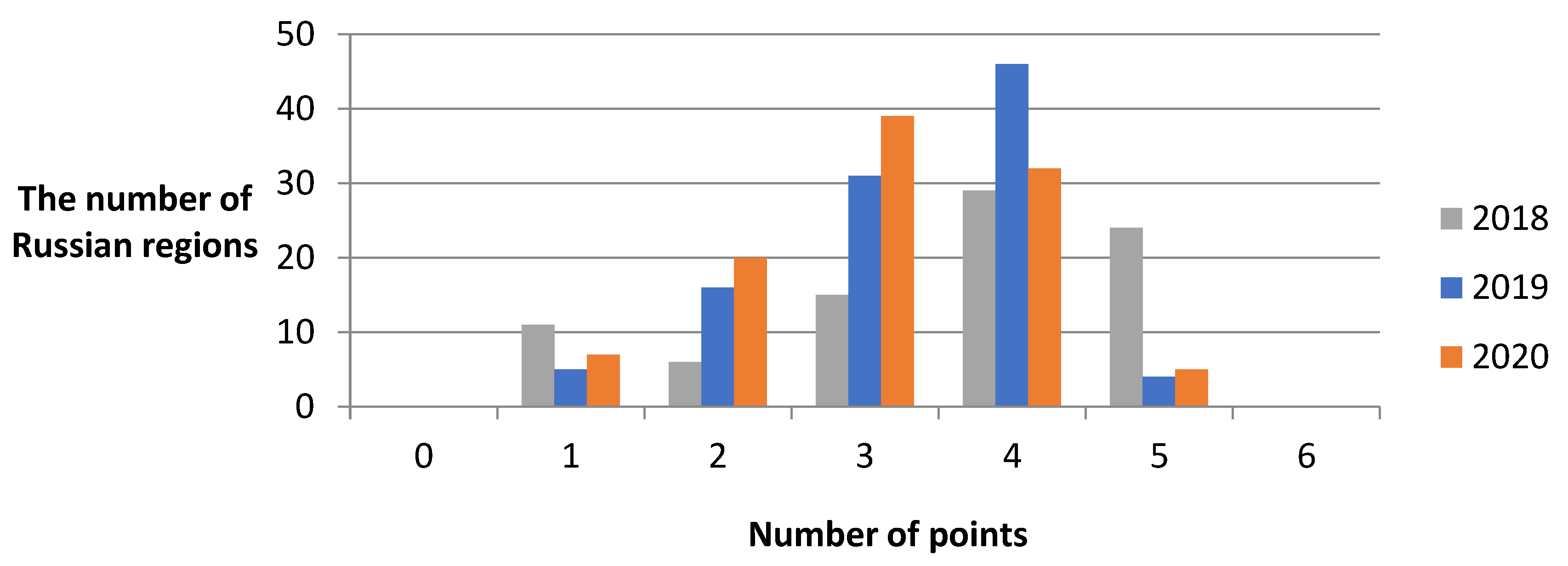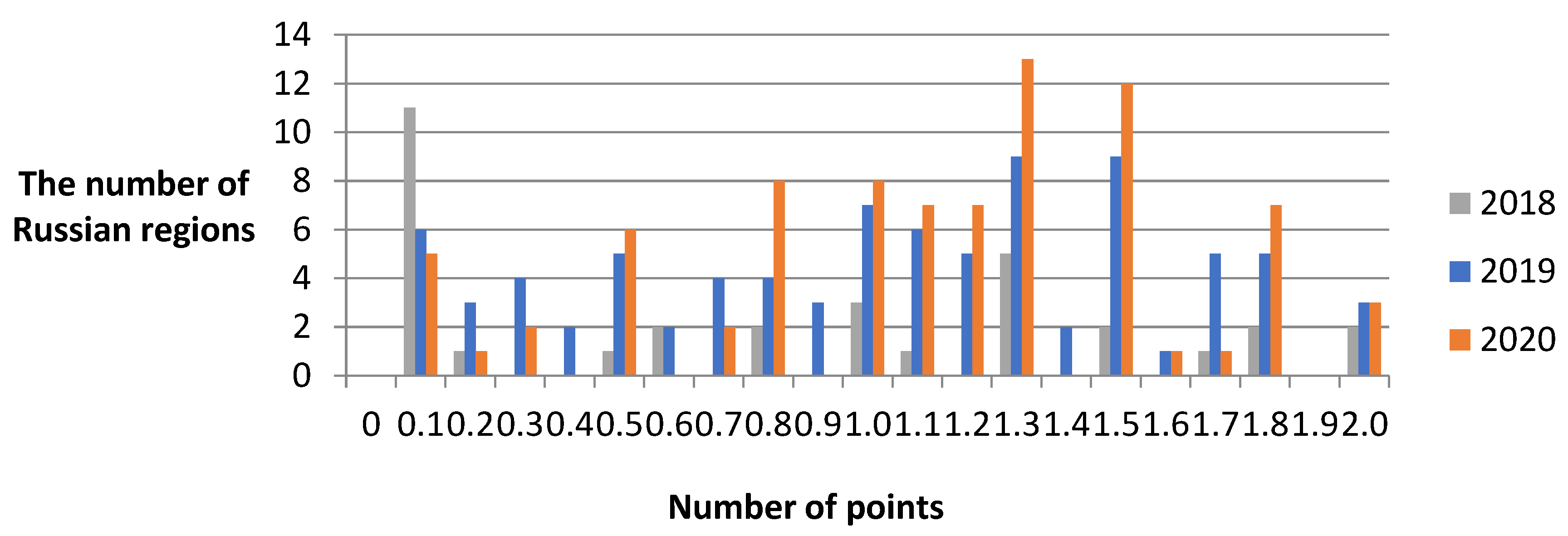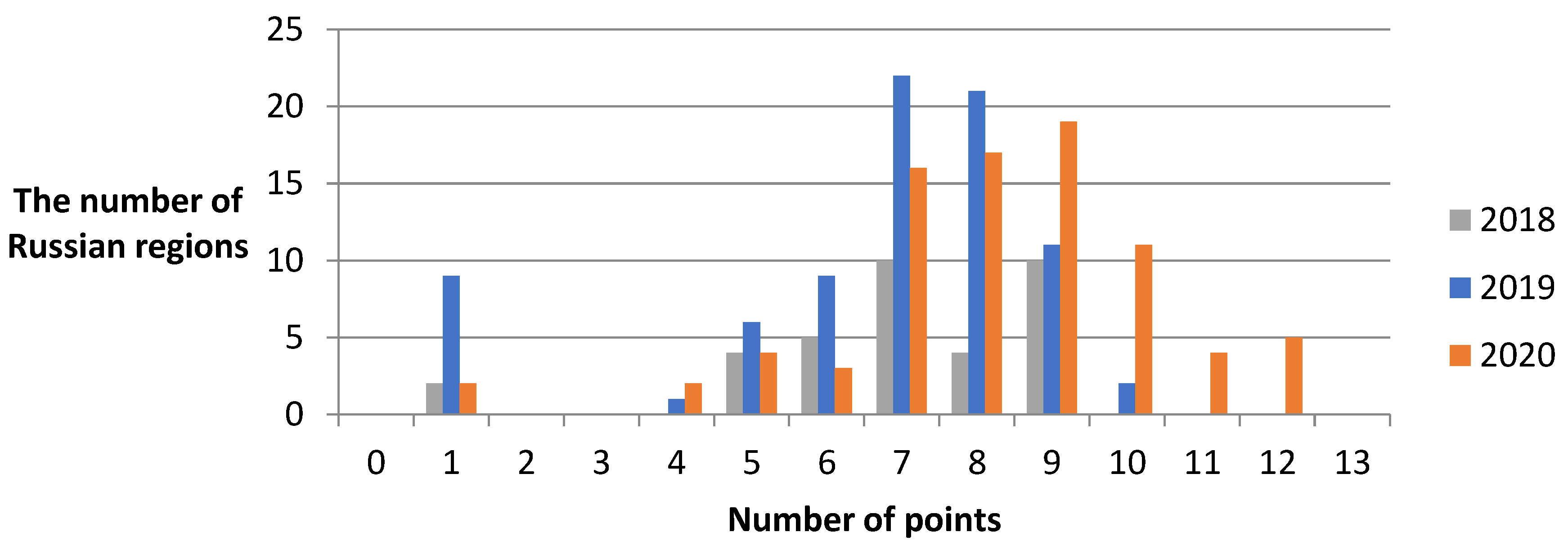Capabilities Approach Application in the Development of Regional Rehabilitation Systems in Russia
Abstract
1. Introduction
2. Materials and Methods
- (a)
- the formation of an integrated approach to the organisation of the system in the region (0–5 points);
- (b)
- the satisfaction of PwD (their legal representatives) with the rehabilitation or habilitation measures (services) (0–2 points);
- (c)
- the staffing of organisations providing rehabilitation and/or habilitation services with specialists (0–2 points);
- (d)
- the formation of the information base of the regional system, taking into account information about the needs of PwD in rehabilitation and/or habilitation services (0–4 points).
- ●
- less than 7.2 points—the regional government should make a decision on the necessity to form the rehabilitation system by developing and implementing a regional programme;
- ●
- from 7.2 to 13.0 points—the regional government should improve the rehabilitation system;
- ●
- exactly 13.0 points—the regional government considers the rehabilitation system to be formed [9].
3. Results
- ●
- the share of PwD (their legal representatives) who are satisfied with the quality of the provision of rehabilitation and/or habilitation measures in the total number of interviewed PwD (their legal representatives) who received rehabilitation and/or habilitation services;
- ●
- the share of PwD (their legal representatives) who positively evaluate the system for the provision of rehabilitation /or habilitation measures in the total number of interviewed PwD (their legal representatives).
4. Discussion
5. Patents
Supplementary Materials
Author Contributions
Funding
Institutional Review Board Statement
Informed Consent Statement
Data Availability Statement
Acknowledgments
Conflicts of Interest
Appendix A
| Terms of the Indicator | Scoring, Points | ||||||||||
|---|---|---|---|---|---|---|---|---|---|---|---|
| 0.0 | 0.1 | 0.2 | 0.3 | 0.4 | 0.5 | 0.6 | 0.7 | 0.8 | 0.9 | 1.0 | |
| The share of organisations providing rehabilitation and (or) habilitation services and included in the regional system regarding the formation of an integrated approach to its arrangement in the total number of organisations providing rehabilitation and (or) habilitation services and located in the region | 0.0–1.0, value rounded to one decimal place | ||||||||||
| Number of regional agencies in various fields of activities (healthcare, education, social protection, physical culture and sports, culture, labour and employment, information and communication) involved in the formation of an integrated approach to the arrangement of the regional system | 0 | - | 1 | - | 2–3 | - | - | 4–5 | - | - | ≥6 |
| Availability of the legal and methodological base of the regional system for forming an integrated approach to its arrangement, agreements on interaction between providers of rehabilitation and (or) habilitation measures | no | - | - | - | - | - | - | - | - | - | yes |
| The share of changes in funding allocated for rehabilitation and habilitation measures to meet the needs of PwD in comparison with the previous period | decline | - | - | - | - | no changes | - | - | - | - | growth |
| Availability of feasible regional recommendations on options for the provision of rehabilitation and habilitation measures for PwD (plan approved by agencies, certificates, co-financing, and others) | no | - | - | - | - | - | - | - | - | - | yes |
| Terms of the Indicator | Scoring, Points | ||||||||||
|---|---|---|---|---|---|---|---|---|---|---|---|
| 0.0 | 0.1 | 0.2 | 0.3 | 0.4 | 0.5 | 0.6 | 0.7 | 0.8 | 0.9 | 1.0 | |
| The share of PwD (their legal representatives) who are satisfied with the quality of the provision of rehabilitation and (or) habilitation services in the total number of interviewed PwD (their legal representatives), % | ≤9.9 | 10.0–19.9 | 20.0–29.9 | 30.0–39.9 | 40.0–49.9 | 50.0–59.9 | 60.0–69.9 | 70.0–79.9 | 80.0–89.9 | 90.0–99.9 | 100.0 |
| The share of PwD (their legal representatives) who evaluate positively the system for the provision of rehabilitation and (or) habilitation services in the total number of interviewed PwD (their legal representatives), % | ≤9.9 | 10.0–19.9 | 20.0–29.9 | 30.0–39.9 | 40.0–49.9 | 50.0–59.9 | 60.0–69.9 | 70.0–79.9 | 80.0–89.9 | 90.0–99.9 | 100.0 |
| Terms of the Indicator | Scoring, Points | ||||||||||
|---|---|---|---|---|---|---|---|---|---|---|---|
| 0.0 | 0.1 | 0.2 | 0.3 | 0.4 | 0.5 | 0.6 | 0.7 | 0.8 | 0.9 | 1.0 | |
| The share of professionals providing rehabilitation and (or) habilitation measures for PwD, who have updated skills and (or) been trained under programs including application of techniques on rehabilitation and (or) habilitation for PwD in the total number of those professionals, % | ≤4.9 | 5.0–9.9 | 10.0–19.9 | 20.0–39.9 | - | 40.0–59.9 | - | 60.0–69.9 | 70.0–89.9 | - | 90.0–100.0 |
| The share of professionals in educational organizations, who have been trained under programs on rehabilitation and for PwD for the last 5 years and teach professionals providing rehabilitation and (or) habilitation measures in the total numbers of those professionals, % | ≤4.9 | 5.0–9.9 | 10.0–19.9 | 20.0–39.9 | - | 40.0–59.9 | - | 60.0–69.9 | 70.0–89.9 | - | 90.0–100.0 |
| Terms of Indicator | Scoring, Points | ||||||||||
|---|---|---|---|---|---|---|---|---|---|---|---|
| 0.0 | 0.1 | 0.2 | 0.3 | 0.4 | 0.5 | 0.6 | 0.7 | 0.8 | 0.9 | 1.0 | |
| Availability of an interagency information system | no | - | - | - | - | - | - | - | - | - | yes |
| The share of PwD, whose data are stored in the interagency information system, % | ≤4.9 | 5.0–19.9 | 20.0–29.9 | 30.0–9.9 | 40.0–49.9 | 50.0–59.9 | 60.0–69.9 | 70.0–79.9 | 80.0–89.9 | 90.0–99.9 | 100.0 |
| The share of organisations providing rehabilitation and (or) habilitation measures in the regions and connected to the interagency information system in the total number of those organisations, % | ≤4.9 | 5.0–19.9 | 20.0–29.9 | 30.0–39.9 | 40.0–49.9 | 50.0–59.9 | 60.0–69.9 | 70.0–79.9 | 80.0–89.9 | 90.0–99.9 | 100.0 |
| The number of rehabilitation and habilitation measures provided to PwD in the Russian region * | ≤3 | - | - | 4–7 | - | 8–10 | - | - | 11–14 | - | ≥15 |
| The share of PwD who received measures that were written in the individual rehabilitation/habilitation programs and determined by the regional agencies in the total number of PwD who received the individual rehabilitation/habilitation programmes in the bureaus of medical and social expertise in the assessment period, % | ≤4.9 | 5.0–19.9 | 20.0–29.9 | 30.0–39.9 | 40.0–49.9 | 50.0–59.9 | 60.0–69.9 | 70.0–79.9 | 80.0–89.9 | 90.0–99.9 | 100.0 |
References
- Anand, P. Wellbeing in Public Policy: Contributions Based on Sen’s Capability Approach. LSE Public Policy Rev. 2021, 1, 78. [Google Scholar] [CrossRef]
- Anand, P.; Hunter, G.; Carter, I.; Dowding, K.; Guala, F.; Hees, M. The Development of Capability Indicators. J. Hum. Dev. Capab. 2009, 10, 125–152. [Google Scholar] [CrossRef]
- Anand, P. Capabilities and Health. J. Med. Ethics 2005, 31, 299. [Google Scholar] [CrossRef] [PubMed]
- Mitra, S. Disability, health and human development. In Palgrave Studies in Disability and International Development; Grech, S., Groce, N., Mitra, S., Eds.; Springer Nature: New York, NY, USA, 2018; pp. 1–177. [Google Scholar] [CrossRef]
- Simon, J.; Anand, P.; Gray, A.; Rugkasa, J.; Yeeles, K.; Burns, T. Operationalising the capability approach for outcome measurement in mental health research. Soc. Sci. Med. 2013, 98, 187–196. [Google Scholar] [CrossRef] [PubMed]
- Bloemen, B.; Pijpers, E.; Cup, E.; Groothuis, J.; van Engelen, B.; van der Wilt, G.J. Care for capabilities: Implementing the capability approach in rehabilitation of patients with neuromuscular diseases. Study protocol of the controlled before-after ReCap-NMD study. PLoS ONE 2021, 16, e0261475. [Google Scholar] [CrossRef] [PubMed]
- Alkire, S. Needs and Capabilities. In The Philosophy of Need; Reader, S., Ed.; Cambridge University Press: Cambridge, UK, 2006; pp. 229–251. [Google Scholar] [CrossRef]
- Rasporyazheniye Pravitel’stva RF ot 18.12.2021 N 3711-r “Ob Utverzhdenii Kontseptsii Razvitiya v Rossiyskoy Federatsii Sistemy Kompleksnoy Reabilitatsii i Abilitatsii Invalidov, v Tom Chisle Detey-Invalidov, na Period do 2025 Goda” [Order of the Government of the Russian Federation of 18 December 2021 No 3711-r “On Approval of the Concept for the Development in the Russian Federation of a System of Comprehensive Rehabilitation and Habilitation of Persons with Disabilities, Including Children with Disabilities, for the Period up to 2025”] (In Russian). Available online: https://docs.cntd.ru/document/727686316?ysclid=l6uqpkmeg9229515438 (accessed on 12 August 2022).
- Prikaz Mintruda Rossii No 545 ot 30.06.2017 “Ob Utverzhdenii Metodiki Otsenki Regional’noy Sistemy Reabilitatsii i Abilitatsii Invalidov, v Tom Chisle Detey-Invalidov”. [Order of the Ministry of Labour and Social Protection of the Russian Federation No. 545 dated of 30 June 2017 “On Approval of the Methodology for Assessing the Regional System of Rehabilitation and Habilitation of Persons with Disabilities, Including Children with Disabilities”] (In Russian). Available online: https://docs.cntd.ru/document/456096926?ysclid=l6uqti74th665694367 (accessed on 12 August 2022).
- GOST R 57888-2017; Rehabilitation of Persons with Disabilities. Goal Indicators of Rehabilitation Services. Fundamentals; National Standard of the Russian Federation. Federal Agency on Technical Regulation and Metrology: Moscow, Russia, 2017; (In Russian). Available online: http://docs.cntd.ru/document/1200157659 (accessed on 12 August 2022).
- GOST R 57960-2017; Rehabilitation of disabled people. Evaluation of rehabilitation services outcomes. Fundamentals; National Standard of the Russian Federation. Federal Agency on Technical Regulation and Metrology: Moscow, Russia, 2017; (In Russian). Available online: http://docs.cntd.ru/document/1200157813 (accessed on 12 August 2022).
- Federal’naya Gosudarstvennaya Informatsionnaya Sistema “Federal’nyy Reyestr Invalidov”. Chislennost’ Invalidov po Polu v Razreze Sub“Yektov RF [The Federal Register of People with Disabilities. Number of Disabled People by Sex by Subjects of the Russian Federation] (In Russian). Available online: https://sfri.ru/analitika/chislennost/chislennost/chislennost-po-polu (accessed on 12 August 2022).
- Federal’naya Gosudarstvennaya Informatsionnaya Sistema “Federal’nyy Reyestr Invalidov”. Chislennost’ Detey-Invalidov po Polu v Razreze Sub“Yektov RF [The Federal Register of People with Disabilities. Number of Children with Disabilities by Sex in the Context of Subjects of the Russian Federation] (In Russian). Available online: https://sfri.ru/analitika/chislennost/chislennost-detei/chislennost-detei-po-polu (accessed on 12 August 2022).
- Federal’naya Sluzhba Gosudarstvennoy Statistiki. Polozhenie Invalidov. Mediko-Social’naya Ekspertiza i Social’noe Obsluzhivanie Invalidov. 2.30 Rekomendacii po Reabilitacii i Abilitacii Grazhdan, Priznannyh Invalidami, za Isklyucheniem Postradavshih v Rezul’tate Neschastnyh Sluchaev na Proizvodstve i Professional’nyh Zabolevanij, 3 August 2022 [Federal State Statistics Service. The Position of the Disabled. Medical and Social Expertise and Social Services for the Disabled. 2.30 Recommendations on the Rehabilitation and Habilitation of Citizens Recognised as Disabled, with the Exception of those Injured in Accidents at Work and Occupational Diseases] (In Russian). Available online: https://rosstat.gov.ru/folder/13964# (accessed on 30 October 2022).
- Federal’naya Sluzhba Gosudarstvennoy Statistiki. Svedeniya o Tekhnicheskikh Sredstvakh Reabilitatsii i Protezno-ortopedicheskikh Izdeliyakh, Kotorymi Obespecheny Invalidy [Federal State Statistics Service. Information about the Technical Means of Rehabilitation and Prosthetic and Orthopedic Products, which are Provided to the Disabled] (In Russian). Available online: https://rosstat.gov.ru/storage/mediabank/tab_2-11.htm (accessed on 12 August 2022).
- Cieza, A.; Stucki, G. Understanding functioning, disability, and health in rheumatoid arthritis: The basis for rehabilitation care. Curr. Opin. Rheumatol. 2005, 17, 183–189. [Google Scholar] [CrossRef] [PubMed]
- Shoshmin, A.V.; Ponomarenko, G.N.; Besstrashnova, Y.K.; Cherkashina, I.V. The application of the International Classification of functioning, disability and health for the evaluation of the effectiveness of rehabilitation: Methodology, practical experience, results. Vopr. Kurortol. Fizioter. Lech. Fiz. Kult. 2016, 93, 12–20. [Google Scholar] [CrossRef] [PubMed]
- Rauch, A.; Cieza, A.; Stucki, G.; Melvin, J. How to apply the ICF for rehabilitation management in clinical practice. Eur. J. Phys. Rehabil. Med. 2008, 44, 329–342. [Google Scholar] [PubMed]
- Díaz Ruiz, A.; Sánchez Durán, N.; Palá, A. An analysis of the intentions of a Chilean disability policy through the lens of the capability approach. J. Hum. Dev. Capab. 2015, 6, 483–500. [Google Scholar] [CrossRef]
- Mitra, S.; Posarac, A.; Vick, B. Disability and poverty in developing countries: A multidimensional study. World Dev. 2013, 41, 1–18. [Google Scholar] [CrossRef]
- World Health Organization. Rehabilitation in health systems: Guide for Action. 2019. Available online: https://www.who.int/publications/i/item/9789241515986 (accessed on 12 August 2022).







Publisher’s Note: MDPI stays neutral with regard to jurisdictional claims in published maps and institutional affiliations. |
© 2022 by the authors. Licensee MDPI, Basel, Switzerland. This article is an open access article distributed under the terms and conditions of the Creative Commons Attribution (CC BY) license (https://creativecommons.org/licenses/by/4.0/).
Share and Cite
Shoshmin, A.; Besstrashnova, Y.; Petrishcheva, K. Capabilities Approach Application in the Development of Regional Rehabilitation Systems in Russia. Societies 2022, 12, 166. https://doi.org/10.3390/soc12060166
Shoshmin A, Besstrashnova Y, Petrishcheva K. Capabilities Approach Application in the Development of Regional Rehabilitation Systems in Russia. Societies. 2022; 12(6):166. https://doi.org/10.3390/soc12060166
Chicago/Turabian StyleShoshmin, Alexander, Yanina Besstrashnova, and Kristina Petrishcheva. 2022. "Capabilities Approach Application in the Development of Regional Rehabilitation Systems in Russia" Societies 12, no. 6: 166. https://doi.org/10.3390/soc12060166
APA StyleShoshmin, A., Besstrashnova, Y., & Petrishcheva, K. (2022). Capabilities Approach Application in the Development of Regional Rehabilitation Systems in Russia. Societies, 12(6), 166. https://doi.org/10.3390/soc12060166






